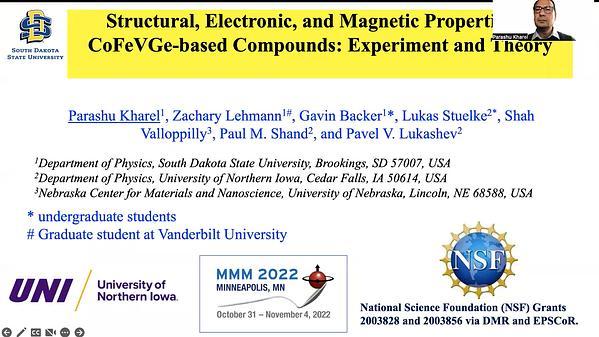Would you like to see your presentation here, made available to a global audience of researchers?
Add your own presentation or have us affordably record your next conference.
In the present work, the microstructure of a zero-field-annealed off-stoichiometric Ni50Mn45In5 Heusler alloy is investigated by magnetic small-angle neutron scattering (SANS) (1). Thanks to its unique mesoscopic length scale sensitivity, magnetic SANS appears to be a powerful technique to disclose the structural and magnetic microstructure of magnetic materials (2) such as nanocrystalline materials (3,4). The neutron data analysis reveals a significant spin-misalignment scattering, which is mainly related to the formation of annealing-induced ferromagnetic nanoprecipitates in an antiferromagnetic matrix. These particles represent a source of perturbation, which, due to dipolar stray fields, give rise to canted spin moments in the surroundings of the particle-matrix interface. The presence of anticorrelations in the computed magnetic correlation function reflects the spatial perturbation of the magnetization vector around the nanoprecipitates. The magnetic field dependence of the zero-crossing and the minima of the magnetic correlation function are qualitatively explained using the law of approach to ferromagnetic saturation for inhomogeneous spin states. More specifically, at remanence, the nanoprecipitates act magnetically as one superdefect with a correlation length that lies outside of the experimental q-range, whereas near saturation the magnetization distribution follows each individual nanoprecipitate. Analysis of the neutron data yields an estimated size of 30 nm for the spin-canted region and a value of about 75 nm for the magnetic core of the individual nanoprecipitates. The presented neutron data analysis (in Fourier and real-space) is particularly useful to study the nanoscale magnetic inhomogeneities of bulk materials at the mesoscopic length scale. Finally, it demonstrates that unpolarized magnetic SANS might be a practicable alternative to time-consuming and low intensity polarized neutron measurements.
This research was partly funded by the National Research Fund of Luxembourg (PRIDE MASSENA Grant No. 10935404 and CORE SANS4NCC Grant).
References:
(1) M. Bersweiler, P. Bender, I. Peral, E. Pratami Sinaga, D. Honecker, D. Alba Venero, I. Titov, and A. Michels, J. Appl. Cryst. 55, in press (2022)
(2) A. Michels, Magnetic Small-Angle Neutron Scattering: A Probe for Mesoscale Magnetism Analysis (Oxford University Press, Oxford, 2021).
(3) M. Bersweiler, E. P. Sinaga, I. Peral, N. Adachi, P. Bender, N. J. Steinke, E. P. Gilbert, Y. Todaka, A. Michels, and Y. Oba, Phys. Rev. Mat. 5, 044409 (2021).
(4) M. Bersweiler, M. P. Adams, I. Peral, J. Kohlbrecher, K. Suzuki, and A. Michels, IUCrJ 9, 65 (2022).
